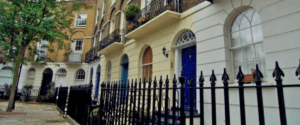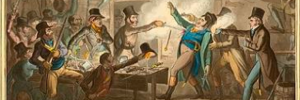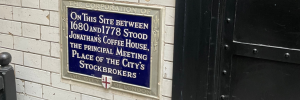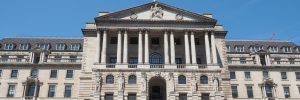Cloudesley square was the first square to be built over the Barnsbury area of Islington and was originally part of the Cloudesley Estate.
The site of the square was formerly known as Stoneyfield and in the C16th was owned by Sir Richard Cloudesley. By the early C19th, the area was leased by dairy farmer Samuel Rhodes (great grandfather of the founder of De Beers diamond company Cecil Rhodes).

It wasn’t long before areas of the Estate were being chosen for new building development. Cloudesley Square was begun in 1825 by carpenter John Emmett, who released land from the Cloudesley Estate and built along the Liverpool Road from 1824 to 1826.
The building of houses was undertaken by a collection of local builders, and primarily in a uniform ‘New River Style’. This familiar style was used in a number of Islington Squares featuring stuccoed ground floor and round headed windows with the upper floors having square headed windows but set within an arched recess with a wrought iron balcony.
A hexagonal railed garden at the centre of the square surrounds Holy Trinity Church by architect Sir Charles Barry of Houses of Parliament fame, built 1826-29, the third of his Islington churches. Barry is one of Britain’s most celebrated architects, responsible for many institutional buildings and churches along with large country houses including the remodelling of Highclere House in Hampshire, Harewood House in Yorkshire and Clivedon in Buckinghamshire.
Holy Trinity Church, Cloudesley Square
The design for Holy Trinity Church is most notably in a style that replicates the design of King’s College Chapel in Cambridgeshire even though on a smaller scale. In 1870s map shows seating for 2,000, in 1890s map shows seating for 13,000.
The east window by Thomas Willement “the Father of Victorian Stained Glass” (Davington Priory, Kent) shows Sir Richard Cloudesley (who died in 1517) kneeling with an inscription of his donation to the parish. Cloudesley left an allowance of straw to the prisoners of Newgate, King’s Bench, Marshalsea and Bedlam, as well as clothes for the poor.
Holy Trinity was the district church until the 1850s, when it was replaced by St Andrew’s at Thornhill Crescent. In 1980 it was leased by the Pentecostal Sect as the Celestial Church of Christ (an independent Christian Church), at which time the railings were also restored. Owing to English Heritage funding this church is open at certain times. The interior has been much changed and is not in a great state of repair. You are required to visit without shoes and under the supervision of blue robed staff.

Cloudesley Square has been the home of some notable residents, including writer and social reformer George Linnacus Banks (from Birmingham) and his wife, poet and novelist Isabella (from Manchester and wrote The Manchester Man) lived at no. 33 in 1864 (North East corner).
“I live for those who love me, for those who know me true,
for the heaven so blue above me, and the good that I can do.”
George Linnaeus Banks



